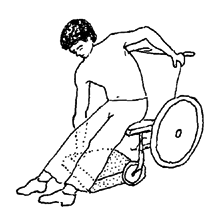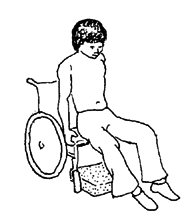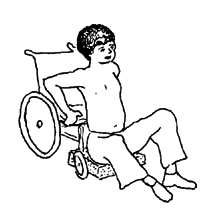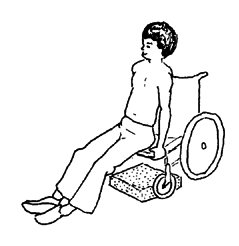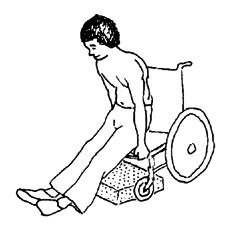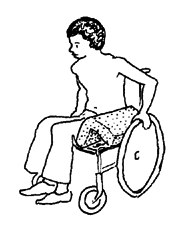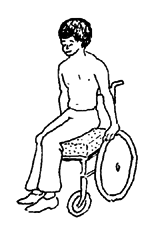Disabled Village Children
A guide for community health workers,
rehabilitation workers, and families
PART 1
WORKING WITH THE CHILD AND FAMILY:
Information on different Disabilities
E. Exercises and Techniques
CHAPTER 43
Crutch Use, Cane Use, and Wheelchair Transfers
USE OF CRUTCHES
MAKING SURE THE CRUTCH FITS THE CHILD
|
When the child stands, the crutch should be 2 or 3 fingers' width below the armpit.
|
|
The elbow should be bent a little so that the child can lift herself up to swing her feet through.
|
|
IMPORTANT Teach the child not to 'hang' on the crutches with her weight on her armpits. WRONG 
In time, pressure on the nerves under the arm can cause paralysis of the hands. Using elbow crutches is a good way to keep her from hanging on her armpits. (However, these are more difficult to use for some children.) RIGHT |
For designs and measurements of different crutches, see Page 584 to 586.
Walking with crutches
TAKING STEPS
Some children walk best by taking steps, one foot at a time.
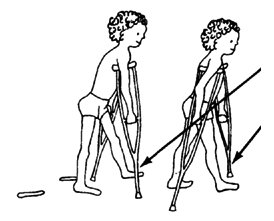
For better balance and position, move the right crutch forward together with the left leg, and then the left crutch together with the right leg.
Her 'tracks' should look like this.
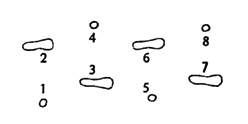
'SWING TO' WALKING
Many children who have difficulty taking steps use crutches by pulling or swinging both feet forward to the level of the crutch tips. Then they advance the crutches and pull themselves forward again.
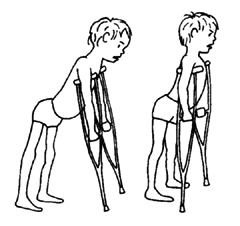
This way is slow but sure.
'SWING THROUGH' WALKING
Although at first they may be afraid to try it, many of these children can learn to 'swing through' between their crutches, like this.
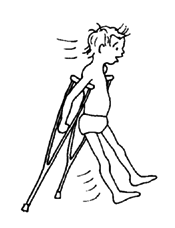
This way is fast and fun.
USE OF A CANE
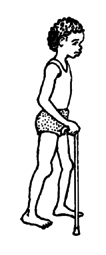
It usually works best to hold the cane on the side opposite the weaker leg.
Move forward and put down the weaker leg and the cane together.
For different crutch and cane designs, see Chapter 63.
His 'tracks' should look like this.
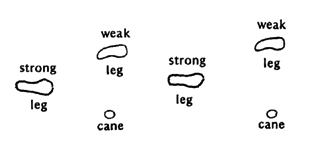
WHEELCHAIR TRANSFERS
Persons who use wheelchairs become much more independent if they can learn to transfer (get in and out of their wheelchairs) by themselves, or with limited help. For those who need some help, it is important to find ways to transfer that make it easiest both for the disabled person and the helper.
Too often, as disabled children get bigger and heavier, mothers and fathers hurt their own backs.
Different persons will discover their own 'best way' to transfer with or without help, depending on their own combination of strengths and weaknesses.
Here we give some suggestions of ways to transfer that many people have found to work well.
|
THE WRONG WAY TO TRANSFER
WARNING: One disability can lead to another! |
Notice that it is often easier to transfer sideways out of a chair, and also back into it. To transfer sideways, however, a wheelchair without armrests, or with at least one removable armrest, is needed. Therefore, for many disabled children, make an effort to get or make wheelchairs without armrests or with removable armrests. Unfortunately, most wheelchairs in many countries have fixed, often very high, armrests. We therefore will give examples of transfers both with and without armrests.
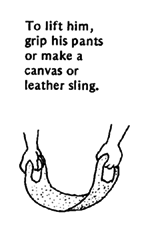
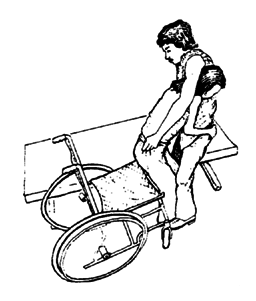
A good way to transfer the child who needs help is like this.
Put the child's feet on the floor and lean her forward against your body. Have her hold on as best she can.
Lift her like this and swing her onto the bed.
Ideas for wheelchair design, adaptation, and use are in Chapters 64, 65, and 66.
Transfer from cot or bed to wheelchair without armrests
|
CAUTION: Make sure brakes are 'on' and footrests are 'up' out of the way. |
To transfer from the wheelchair to the cot, follow the same steps in reverse.
|
1. Push yourself to a sitting position. |
|
2. Reach under knees one at a time. |
|
3. Move legs so that feet are on the floor. |
|
4. Make sure brakes are locked. Then push up on arms while leaning forward with head facing down. Weight should be over knees. |
|
5. Move body into wheelchair. |
Transfer from cot or bed to wheelchair with armrests
|
1. Position your wheelchair so that you can swing body past armrests. |
|
2. Place one hand on bed and one on the far armrest. Push yourself up while leaning forward with head down, weight over knees. |
|
3. Swing body into wheelchair. |
Transfer forward from wheelchair to cot or bed (often works well for children)
|
1. Lift feet onto bed and wheel the chair forward against bed. Put on brakes. Then bend forward and lift butt forward on chair. |
|
2. With one hand on the cushion and one on the bed, lift the body sideways onto the bed. |
|
3. Repeated lifts and lifting of legs may be needed. |
Transfer with sliding board -without help

For getting into and out of bed, a car, etc.
|
1. Place board under hip by leaning to opposite side or by pulling up leg. |
|
2. Lean forward, with your head and weight over knees. |
|
3. Push yourself along the board. |
|
4. When you are in the chair, remove the board and put it where you can easily get it. |
Transfer with sliding board -with help
|
1. Lift leg and put board under hip. |
|
2. Have person put arms around neck (if possible) while you put your hands under his butt, or grab his pants. |
|
3. Slide the person along board to bed. |
|
4. Lift legs onto bed. |
Transfer from floor to wheelchair - with help of a low seat
|
1. Sit with legs straight, Pull seat to your side opposite the wheelchair (a person's knee can also be used). |
|
2. With hands on each chair, push up, with your head forward over knees. |
|
3. Swing onto the seat. |
|
4. Now, with your head forward over your knees, swing body onto the wheelchair. |
Transfer from wheelchair to floor -and back again -without help of a stool
|
1.
|
|
2.
|
|
3.
|
|
4. 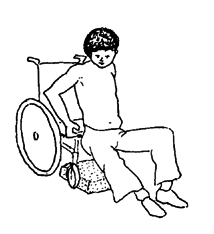
|
|
5.
|
|
6.
|
|
7.
|
|
8.
|
|
9.
|
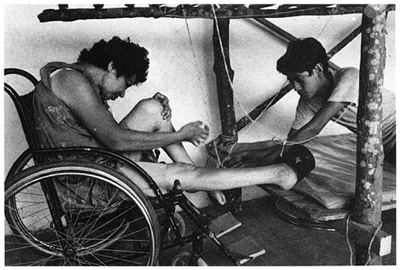
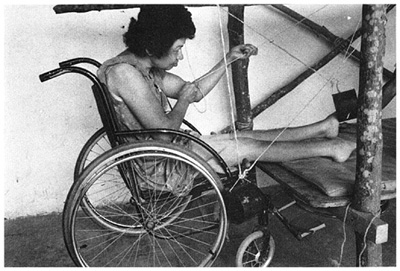
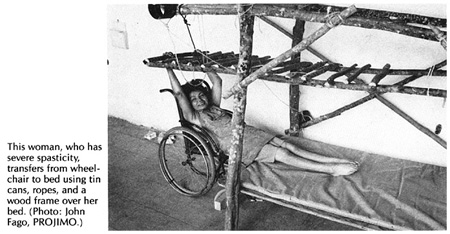
Disabled Village Children
A guide for community health workers,
rehabilitation workers, and families
by David Werner
Published by
The Hesperian Foundation
P.O. Box 11577
Berkeley, CA 94712-2577

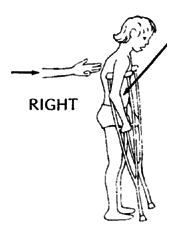
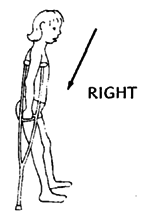
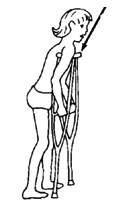

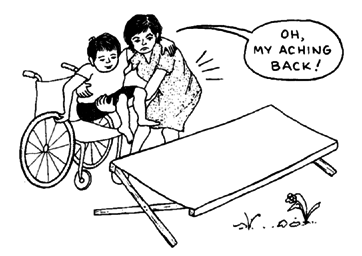
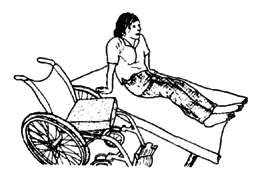
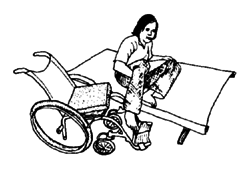
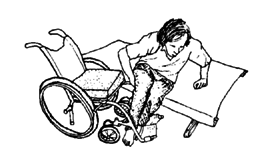
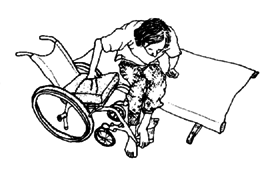
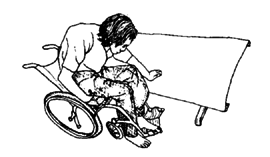
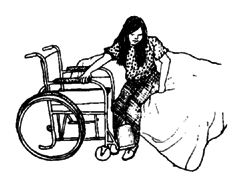
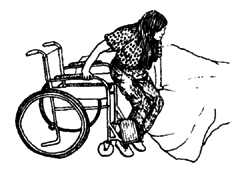
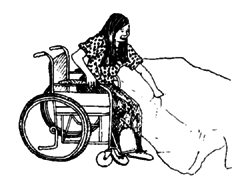
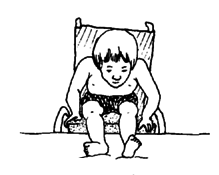
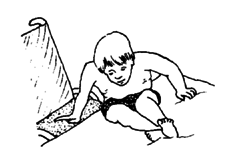
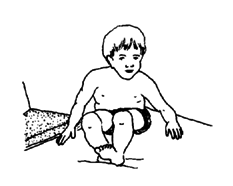
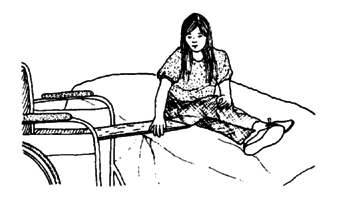
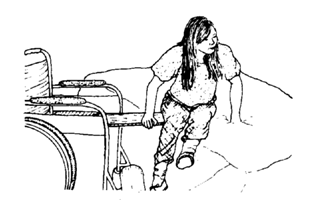
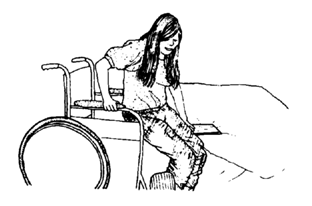
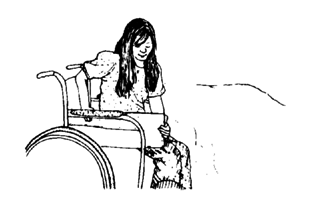
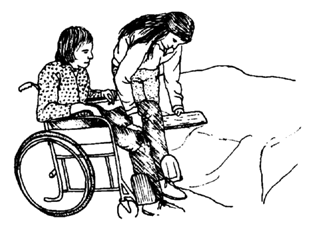
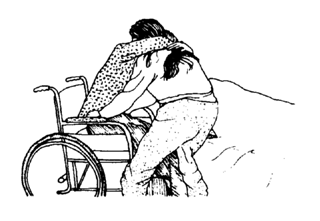
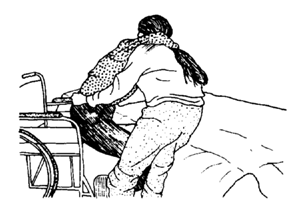
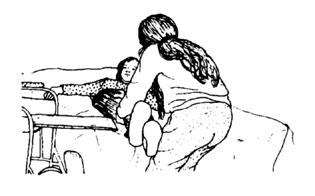
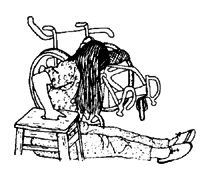
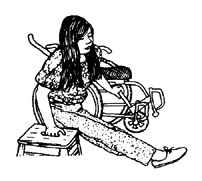
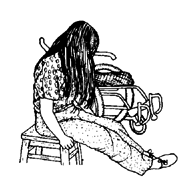
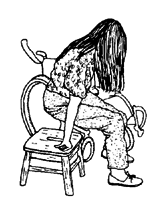
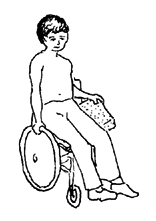 .
.